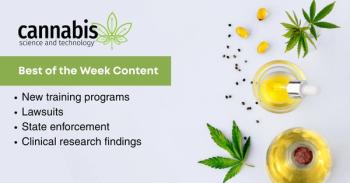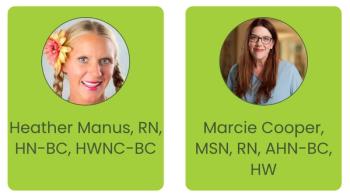
- August 2021
- Volume 2
- Issue 2
Cannabis Becomes One Nurse’s Tool to Treat Epilepsy Disorders
Nurse Janna Champagne shares her passion for educating patients, her peers, and more.
In 2012, Janna Champagne, BSN, RN, was introduced to the cannabis industry as a patient when she experienced an immune health collapse. After this traumatic health episode, Champagne became a regular medical cannabis patient herself (1). Through using cannabis as a treatment, she was able to wean herself off of the pharmaceuticals she had become dependent on. What Champagne went through next was miraculous—she experienced a complete reversal of her autoimmune disease.
Champagne’s cannabis journey didn’t end there. A few years later, her autistic daughter entered her puberty years and suddenly began developing very extreme behaviors, such as self-injury, aggression towards others, and property destruction. Champagne saw how cannabis had helped her medically, so she tried treating her daughters’ symptoms with the medicinal plant. With medical cannabis, her daughter’s symptoms eased and spared her from having to be admitted to out of home placement due to safety issues. Champagne calls both of these experiences her "cannabis passion makers."
Medicinal Prowess for Seizure Disorders
Knowledge about the medicinal powers of the cannabis plant are growing in awareness. Aside from using cannabis as a treatment for various other health conditions and illnesses, Champagne has supported epilepsy patients through education, resulting in success using cannabis with outcomes including a reduction in antiepileptic drug (AED) pharmaceutical reliance. Cannabidiol (CBD) has become the primary cannabinoid that people seek for their seizures. “When they add CBD to their regimen, oftentimes they’re able to reduce reliance on their pharmaceuticals for epilepsy or seizures and improve their quality of life and improve their function because cannabis side effects are not nearly in the same ball court as the AEDs and anti-seizure drugs,” said Champagne.
Often what is seen, is an improvement in quality of life and function. “Sometimes CBD is even effective for patients that haven’t been able to improve their seizure disorder with the pharmaceuticals. Where the pharmaceuticals have failed, CBD will sometimes come in and offer them that support that they need,” she said.
Stigma Still Exists in the Age of Cannabis
Although the cannabis industry is on the rise and scientific research is beginning to get the attention it deserves, there are still medical professionals and patients who have difficulty looking past earlier decades when the plant was known more for its “recreational high” than its medicinal properties. “Often patients are fearful due to the unwarranted stigma attached to cannabis and offering them general education about its safety profile and the reputable research can really help ease those concerns,” Champagne explained.
Now, her primary role is educating medical professionals about endocannabinoid science because it is not taught in either medical or nursing schools. Through this education endeavor, Champagne is helping to get the beneficial information of cannabis to more patients and empowering healthcare professionals to discuss this option more with their patients and other peers. Champagne believes education is the best tool to help chip away at the stigma because that "reefer madness" connotation is often all that people know about the plant.
Another major thing helping to grab medical professionals’ attention are the positive patient outcomes. Once they begin hearing other patients’ successes, they become curious and investigate further on the plant themselves. There are tens of thousands of reputable research studies supporting cannabis for numerous health conditions. “When you consider this dichotomy that we freely allow and even have insurance paying for medications like opioids that are killing patients every half hour—there really is no ethical reason why cannabis shouldn’t be a primary consideration for these patients,” Champagne explained. “As medical professionals, we’ve all taken oaths to help patients objectively weigh the risk versus benefit of all their options. And when you include cannabis in that assessment, it’s usually the first logical choice.”
In the US, cannabis is classified as a Schedule I drug, some health experts view this as a liability because it’s in the same group as meth, heroin, LSD, and many others. “Once you start educating and really teach that, number one, cannabis objectively meets zero of the three criteria for Schedule 1 placement. And we’ve had federal DEA judges agree with us and recommend descheduling since 1988. Yet, we’re still fighting to have it removed,” Champagne commented.
To be in the Schedule I class, the subject needs to be harmful, addictive, and have no accepted medical use. In the 5000 years of medical cannabis use, there have not been any deaths. The plant is even less addictive than items such as sugar and caffeine which are freely available. “Our very own government holds patents for cannabis as medicine like number 6630507 is a pretty popular one. Obviously, it’s just pure hypocrisy that cannabis is scheduled at all, and the Schedule 1 placement is not in the best interest of patients,” said Champagne.
Finding the Right Medical Cannabis Product
No two living organisms are the same. Everyone is created to be different and through those differences, our bodies react differently to the things we put in them. Like pharmaceuticals don’t always cause the same side effects, cannabis works divisively as well. There is a lot of research supporting cannabis and cannabinoids in the medical field. CBD is among the more popular cannabinoids used in treating medical conditions. Champagne explained that not everyone responds to CBD. In these cases, patients are pointed towards trying other cannabinoids such as, tetrahydrocannabinolic acid (THCA) or cannabidiolic acid (CBDA). “I always encourage looking for products that have a terpene profile that’s really conducive to targeting seizures, like myrcene, which helps cross the blood brain barrier according to research, or linalool, which has research-supported anti-seizure properties in its own right. Those can be really beneficial terpenes to look for in a cannabis product to target seizures,” said Champagne.
Research has shown that whole plant spectrum formulations are the prime option for treating seizures (2). Some isolates or products are processed in ways where they are stripped of the hundreds of compounds found in the cannabis flower. Research studies experimenting with CBD have demonstrated how the cannabinoid avoids the psychoactive effects of the endocannabinoid system to provide a well-tolerated and promising therapeutic alternative for the treatment of seizures. As cannabis begins to receive more research funding, further data can be discovered on how the cannabis plant can be used to help seizure disorder patients and potentially allow them to live seizure-free, thereby improving their quality of life.
Guiding the Patient Along in the Process
When Champagne taught patients, she started with a comprehensive assessment of their individual situation. This included screening for any pharmaceuticals being used, to create a targeted education plan. It's important to review medications, because interactions with pharma are possible, and combined too closely they may impact the effect of cannabis. “Education ensures that patients are empowered with evidence-based and research-supported facts, so they know what is bound to be optimal for their specific needs. It’s so important that patients have that autonomy to make their own wellness decisions and have the ability and are educated enough to make a well-informed decision," said Champagne. “We also produced a patient handbook that provides a lot of general guidance and a journal for patient response tracking. We really taught them how to approach it. What products they might want to start with in their experimentation, plus a bunch of tools to help them track their response and really figure out what is the best regimen for their specific needs.”
Unfortunately with cannabis, it can be difficult some times to find coverage to help with the costs. There are a lot of patients who pay out-of-pocket for their treatments. Champagne hopes this will change in the future but for now, she is working with her partner in Holistic Caring, Elizabeth Mack, MBA, RN, Founder of Holistic Caring, who has a history as a nurse in insurance companies. At this time, there are some Health Savings Accounts (HSAs) that will reimburse patients for their cannabis.
Champagne is also a founding member of the Cannabis Nurses Network (3)—an organization that helps cannabis nurses through accreditation, education, recognition, and advocacy efforts. The institution has an advocacy committee where patients can seek guidance and try to get reimbursement from their insurance companies. Dealing with insurance companies is not a simple process. Oftentimes, patients have to submit a bill and the insurance can deny it, after which patients can appeal it and take the decision to higher levels to try and have the situation end up in their favor. “Sometimes it’s helpful when patients can present a list of pharmaceuticals that they were able to discontinue on behalf of having started cannabis and the cost of those compared with the cost of the cannabis. That can be a way that patients can sort of advocate for their own insurance reimbursement,” she noted.
Next Level Patient Guidance: Cannabis Nurses Approved and Integrated Holistic Care
Champagne's passion to follow patients’ needs led to the inspiration for Cannabis Nurses Approved (4)—a group of cannabis-specialty nurses who work with patients and help guide them to find optimal products for medical use by screening cannabis suppliers to ensure they meet criteria for medical quality. She realized that a profound number of cannabis patients need to understand how the very extensive options of retail cannabis products differ, and how to choose among those products for the optimal therapeutic use. The organization never benefitted from the sales of any product and did not accept commissions because they felt it was important that they were objective educators to patients. Any information they provided was supported by scientific research.
“Patients are really vulnerable to misinformation, which unfortunately is prolific in the cannabis industry,” said Champagne. “There’s a lot of deceptive marketing tactics. For example, CO2 extraction takes this cannabis flower with 500 compounds and strips it down to a dozen or a couple of dozen compounds. Removing the antioxidants, the bioflavonoids, essential fatty acids, the chlorophyll, and they’ll call that full spectrum. That’s extremely deceptive to patients. We saw a lot of patients being taken for a ride and they would call us and sometimes they’d already bought product.”
So, depending on the product, nurses would offer advice: “Best case scenario, we might say, 'sorry, that’s not optimal.' Worst case scenario it might be, “wow, your neighbor made it. We don’t know the strain. It’s not lab tested. We really can’t condone its use because it could it could actually have some toxins in it that would be harmful,” said Champagne. “We got tired of this scenario with patients, and that’s really what spawned Cannabis Nurse Approved.”
Champagne also founded Integrated Holistic Care (5), which focuses on medical cannabis education and has served thousands of individual patients, supporting their success in achieving their optimal health goals. Champagne's role has now progressed to include educating medical professionals, through both accredited and college-level cannabis courses. Through these educational efforts, she is able to reach more patients than she would be able to do on her own.
Advocacy Efforts
Champagne's cannabis passion doesn’t stop at education: She is also currently advocating in Oregon for cannabis nurses and patients to have the right to educate and receive education by nurses. Champagne advocates through Autism Safe Haven (6) a nonprofit organization, which she is also a founder of, and focuses on cannabis inclusive care resources specifically for autism. Future plans include expanding on other conditions such as Alzheimer’s, cancer, mental health, hospice, and other areas where cannabis has been shown to be beneficial for those patients. “Unfortunately, when somebody is placed in a facility or placed out of home, out of necessity, oftentimes their ability to access cannabis ends because of federal regulations, because of fear on the part of some of those businesses," she explained. “That’s
really the focus of our advocacy—to improve access for
those patients.”
Champagne also spends time advocating for cannabis legislation. She has participated in various videos advocating for Jim Bartell (7), who lost his son, Ryan, to stage four pancreatic cancer. Bartell is fighting to get a bill in California dedicated after his late son (8). “Ryan’s Law, if it passes in the state of California, will allow patients who are hospitalized the right to use their cannabis therapy. This is the third year they’re trying to push it through. It’s on Gavin Newsom’s desk right now. Last year, he vetoed it and the year before, I don’t think it quite made it to him,” she explained.
Optimism for the Future
Like many cannabis supporters, Champagne hopes to see the plant federally descheduled and decriminalized. There is scientific data highlighting the medicinal properties of cannabis and that it means no harm. The stigma surrounding cannabis and its’ “reefer years” have greatly prevented legislation and research from moving forward. How can we depict the cannabis plant as something so dangerous yet, there is so much we do not know about it?
“Realistically, I would love to see a separation between the whole plant with its unsurpassed safety profile, which should just be a basic human right, whereas human altered products can't boast safety or efficacy matching whole plant cannabis,” said Champagne (9). “I think those human altered forms are perfect to hand to the pharmaceutical companies and let them make their taxes and their money or profits off of it. But the whole plant should be free to everybody.”
Additional Resources
Cannabis’s scheduling and federal illegalization prevent many from gaining helpful information. For nurses in states where medical cannabis may not be available, she recommends turning to the Cannabis Nurses Network. It’s a great place to start and build a support network where they are able to meet other nurses in their state to collaborate with. This helps gain support and help advocate in the changing of their laws. There are also committees and other individuals who are willing to share information, educate nurses, and help encourage their efforts. “They learn how to educate and promote legal access through the regulatory and legislative channels. That’s a really powerful tool for a nurse that’s in a state where there cannabis is not legal,” said Champagne. “I’m in Oregon. I know even despite the troubles we have here, we’re pretty spoiled. We have very ready access. I definitely know there’s nurses in other states like Idaho where even CBD is gray area, unfortunately. But, the Cannabis Nurses Network is definitely a great resource for any nurses that are looking to learn about medical cannabis, learn how to advocate, and really just receive that support and encouragement from other nurses that are on the same track.”
With uncertainty on when legislation will help shape the cannabis industry in its favor, it’s important to not give up, get involved, and help spread awareness of how beneficial cannabis can be. Much still needs to be changed so that patients and healthcare professionals are able to freely discuss and recommend cannabis as treatment options. This medicinal plant may just be the future in treating numerous health conditions which plague patients with symptoms and serious pharmaceutical-induced side effects.
References
https://jannachampagne.com .https://www.ncbi.nlm.nih.gov/pmc/articles/PMC4604191/ .https://www.cannabisnursesnetwork.com .https://www.cannabisnurseapproved.com .https://www.integratedholistic.com .https://autismsafehaven.org .https://unitedpatientsgroup.com/podcast/jim-bartell-janna-champagne-rn-ryans-law/ .https://www.thedesertreview.com/news/california-lawmakers-introduce-bill-allowing-terminally-ill-patients-to-access-medical-cannabis-in-healthcare-facilities/article_054d966a-8cb5-11eb-b7ea-c383f88a8cb0.html .https://cbdhealthandwellness.net/oct-nov-2020-edition/?fbclid=IwAR0lO2fxpX1HLmZE8B3i8s9iEqwGcyuPttTOVBUB9Fv74M7rzu_OCvu_Otg#dflip-df_4981/48/ .
Articles in this issue
over 4 years ago
August 2021 Digital Editionover 4 years ago
Medical Cannabis and Caregiver Rights in Hawaiiover 4 years ago
Charlotte Figi: Patient, Advocate, Trailblazer, and Much MoreNewsletter
Unlock the latest breakthroughs in cannabis science—subscribe now to get expert insights, research, and industry updates delivered to your inbox.



